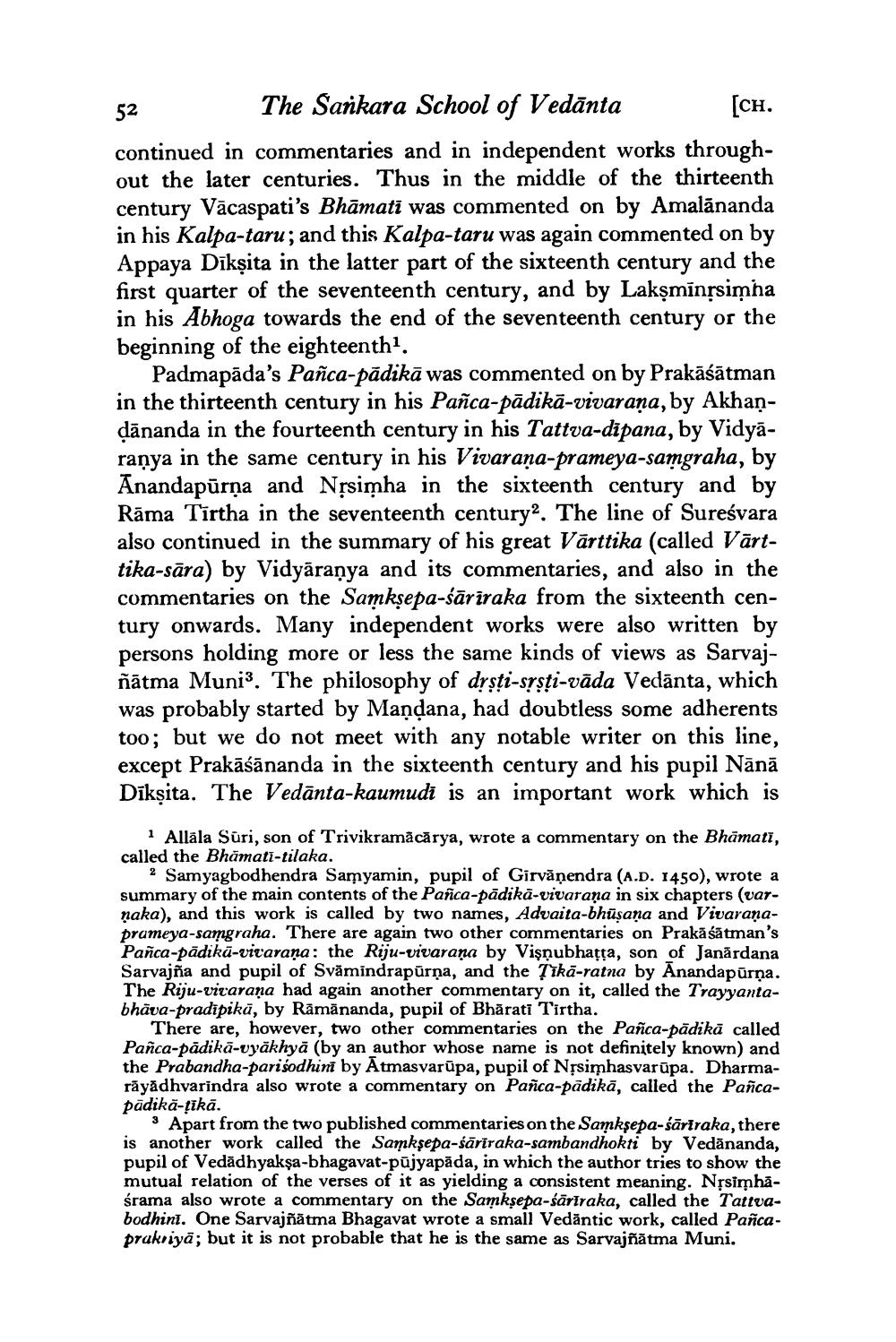________________
52
The Sankara School of Vedānta
[ch. continued in commentaries and in independent works throughout the later centuries. Thus in the middle of the thirteenth century Vācaspati's Bhāmati was commented on by Amalānanda in his Kalpa-taru; and this Kalpa-taru was again commented on by Appaya Dikșita in the latter part of the sixteenth century and the first quarter of the seventeenth century, and by Lakşmīnțsimha in his Abhoga towards the end of the seventeenth century or the beginning of the eighteenth?.
Padmapāda's Pañca-pădikā was commented on by Prakāśātman in the thirteenth century in his Pañca-pādikā-vivarana, by Akhandānanda in the fourteenth century in his Tattva-dipana, by Vidyāranya in the same century in his Vivarana-prameya-samgraha, by Anandapūrņa and Nșsimha in the sixteenth century and by Rāma Tīrtha in the seventeenth century. The line of Sureśvara also continued in the summary of his great Värttika (called Vārttika-sāra) by Vidyāraṇya and its commentaries, and also in the commentaries on the Samksepa-śārīraka from the sixteenth century onwards. Many independent works were also written by persons holding more or less the same kinds of views as Sarvajñātma Muni3. The philosophy of drsți-sysți-vāda Vedānta, which was probably started by Mandana, had doubtless some adherents too; but we do not meet with any notable writer on this line, except Prakāśānanda in the sixteenth century and his pupil Nānā Dīkṣita. The Vedānta-kaumudi is an important work which is
1 Allāla Sūri, son of Trivikramācārya, wrote a commentary on the Bhāmati, called the Bhāmatī-tilaka.
2 Samyagbodhendra Samyamin, pupil of Girvāṇendra (A.D. 1450), wrote a summary of the main contents of the Panca-pădikā-vivarana in six chapters (varnaka), and this work is called by two names, Advaita-bhūsana and Vivaranaprameya-samgraha. There are again two other commentaries on Prakāśātman's Pañca-pădikā-vitarana: the Riju-vivarana by Vişnubhatta, son of Janārdana Sarvajña and pupil of Svămindrapūrņa, and the Įikā-ratna by Anandapūrna. The Riju-vitaraṇa had again another commentary on it, called the Trayyantabhāva-pradipikā, by Rāmānanda, pupil of Bhărati Tirtha.
There are, however, two other commentaries on the Panca-pădikā called Panca-pădikā-vyakhyā (by an author whose name is not definitely known) and the Prabandha-parisodhini by Atmasvarūpa, pupil of Nșsimhasvarūpa. Dharmarāyadhvarindra also wrote a commentary on Panca-padikā, called the Pancapadikā-ţikā.
3 Apart from the two published commentaries on the Samkşepa-śārtraka, there is another work called the Samkşepa-śārīraka-sambandhokti by Vedānanda, pupil of Vedadhyakşa-bhagavat-pūjyapāda, in which the author tries to show the mutual relation of the verses of it as yielding a consistent meaning. Nýsimhāśrama also wrote a commentary on the Samksepa-säriraka, called the Tattvabodhini. One Sarvajñātma Bhagavat wrote a small Vedāntic work, called Pancaprakriyā; but it is not probable that he is the same as Sarvajñātma Muni.




